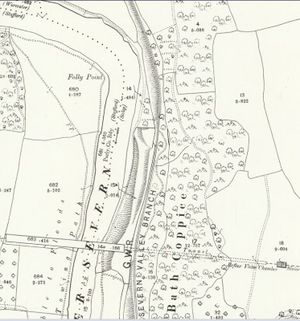Difference between revisions of "Folly Point Siding"
From SVR Wiki
(add photo) |
m (add links) |
||
| (One intermediate revision by the same user not shown) | |||
| Line 1: | Line 1: | ||
| − | [[File:GWRplanFollyPoint.jpg|thumb|300px|right|Map showing the location of the siding]] | + | [[File:GWRplanFollyPoint.jpg|thumb|300px|right|Map showing the location of the siding (orientation differs from OS Map)]] |
| + | [[File:OS Folly Point 1901.JPG|thumb|300px|right|Map showing the general locality]] | ||
Folly Point siding was installed by the GWR for the use of contractors building the [[Elan Valley Aqueduct]]. It was situated to the west of the line and was controlled by two ground frames of two levers each, locked by a key on the electric train staff for the section.<ref name=JM>[[Bibliography#Books|Marshall (1989)]] p. 95.</ref> | Folly Point siding was installed by the GWR for the use of contractors building the [[Elan Valley Aqueduct]]. It was situated to the west of the line and was controlled by two ground frames of two levers each, locked by a key on the electric train staff for the section.<ref name=JM>[[Bibliography#Books|Marshall (1989)]] p. 95.</ref> | ||
| Line 5: | Line 6: | ||
==See also== | ==See also== | ||
| − | [[Folly Point]] | + | *[[Folly Point]] |
| + | *[[Private sidings connected to the Severn Valley Railway]] | ||
| + | *[[List of signal boxes#List of historical Signal Boxes and Ground Frames | List of historical Signal Boxes and Ground Frames]] | ||
| + | |||
==References== | ==References== | ||
<references/> | <references/> | ||
Latest revision as of 17:35, 30 November 2018
Folly Point siding was installed by the GWRGreat Western Railway for the use of contractors building the Elan Valley Aqueduct. It was situated to the west of the line and was controlled by two ground frames of two levers each, locked by a key on the electric train staff for the section.[1]
The siding was approved by the Board of Trade for use on 16 September 1899, and was removed when construction of the aqueduct was completed in 1906[1].
See also
- Folly Point
- Private sidings connected to the Severn Valley Railway
- List of historical Signal Boxes and Ground Frames
References
- ↑ 1.0 1.1 Marshall (1989) p. 95.

